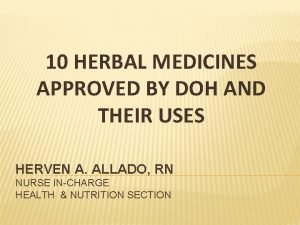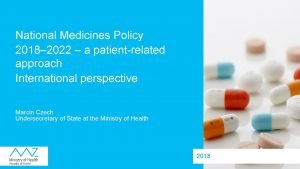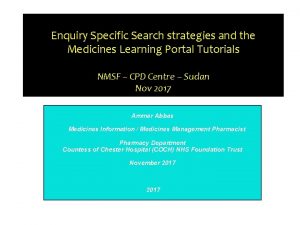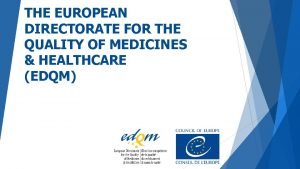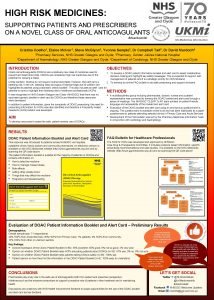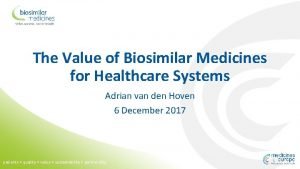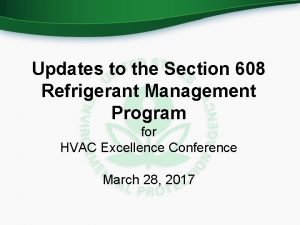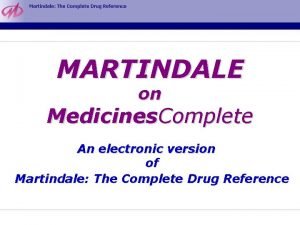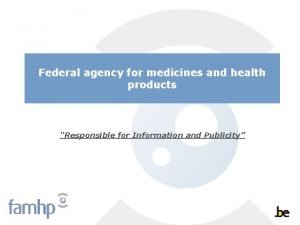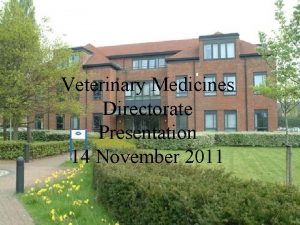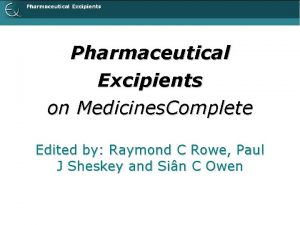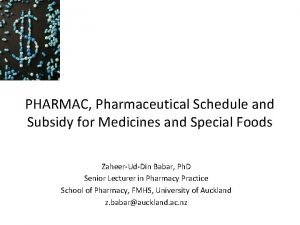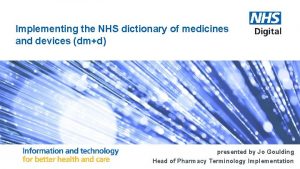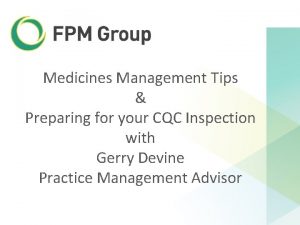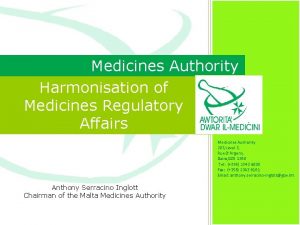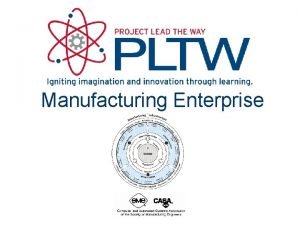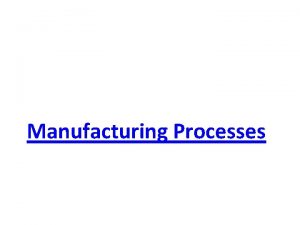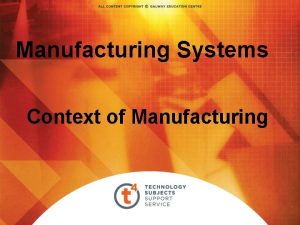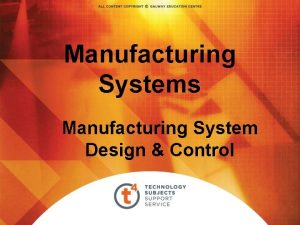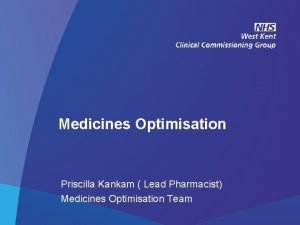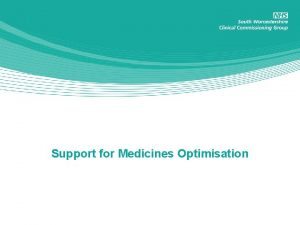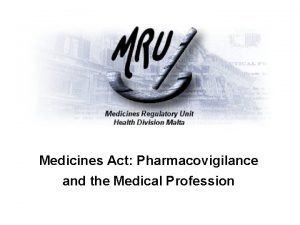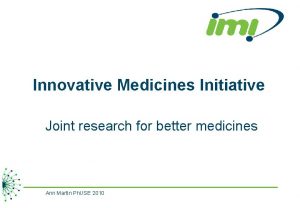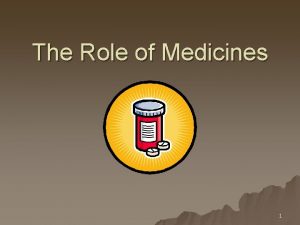Medicines Manufacturing in the UK 2017 Medicines Manufacturing






































































- Slides: 70

Medicines Manufacturing in the UK 2017

Medicines Manufacturing in the UK 2017 Welcome by Andy Evans Chair, MMIP Site Lead, AZ Macclesfield

Morning Agenda 10: 00 Introduction Steve Thompson ABPI Steve Bates BIA Sue Dunkerton KTN 10: 30 Keynote Speech Lord Prior of Brampton, Minister, BEIS 10: 45 MMIP Achievements & Ian Mc. Cubbin 11: 00 MMIP Overview 12: 00 Lunch & Tours Richard Turner Magda Papadaki Sean Bermingham Clive Badman Alex Felthouse Yvonne Stewart

Afternoon Agenda 14: 00 How manufacturing might be evolving Ian Mc. Cubbin Prof Lionel Clarke Steve Bagshaw Andy Evans Roger Kilburn 14: 50 MMIP’s Response to the Industrial Strategy Andy Evans 15: 30 Break-out Groups Richard Turner Alex Felthouse Magda Papadaki Mike Sullivan Andy Evan 16: 15 Feedback & Close Out Andy Evans 17: 00 Drinks Reception Close out 18: 00

Medicines Manufacturing in the UK 2017 Introduction by ABPI, BIA, KTN Mike Thompson, Chief Executive ABPI Steve Bates, Chief Executive BIA Sue Dunkerton, Director KTN

Medicines Manufacturing in the UK 2017 KTN and MMIP Connecting people to accelerate innovation Sue Dunkerton OBE Director Knowledge Transfer Network

Knowledge Transfer Network (KTN) • UK’s Innovation Network • Connecting the unusual suspects to accelerate innovation • Seeking to ensure value is created from every great idea

Industrial Strategy • Industrial Strategy Challenge Fund workshops – 800 leaders in 9 workshops over 1 fortnight • Leadership Councils – Medicines Manufacturing (MMIP)/Advanced Therapies (ATMTF), Industrial Biotechnology (IBLF), Advanced Materials (AMLC), Synthetic Biology (SBLC), Chemistry Growth Partnership (CGP) etc • Reports and Roadmaps

Navigating the landscapes

Working with the funders

Connecting communities MEDTECH SYNTHETIC BIOLOGY DIGITAL HEALTH IOT MATHEMATICS PACKAGING DIGITAL MANUFACTURING ROBOTICS AND AI FORMULATION

Progress within MMIP • Advanced Therapies Manufacturing Taskforce and Action Plan • Initiated and supported AMSCI ADDOPT AMSCI - £ 20. 4 M Govt-industry-academia collaboration • Delivered the Medicines Manufacturing Landscape Portal • Ran the smart packaging scoping workshop for MMIP using cross KTN expertise • Championed Technology Clubs such as BRIC for the biologics /bioprocessing community

New areas of relevance Innovation and Local Science and Innovation Audits (SIAs) Diversity in Innovation

The Future. Faster Connecting people to accelerate innovation The Future. Faster sue. dunkerton@ktn-uk. org

Medicines Manufacturing in the UK 2017 Keynote speech Lord Prior of Brampton Minister, Department for Business, Energy and Industrial Strategy

Challenge 1: the UK has lagging productivity at national level – and needs to transform productivity growth to catch up Source: BCG, OECD

Challenge 2: significant unevenness in productivity in different places and sectors

Response: Our green paper leading to an Industrial Strategy

Life science investment is globally competitive – multiple established and emerging hubs

The UK has world-leading universities and a strong, well-distributed research base

UK life science exports lower than those of Germany and the US – we can do better Source: ONS UNCTAD STAT Data, World Bank

Small molecule manufacturing is an example where the UK capabilities can become world leading Current UK position Opportunities to become world leaders Critical mass of manufacturing in this area as well as strong academic capabilities especially in chemical engineering scale of manufacture required is reducing and product potency is increasing leading to worldwide gaps in capabilities ▪ Improved productivity through continuous processing and processing analytical technology offer opportunities ▪ New modalities (e. g. , Antibody Drug Conjugates, oligonucleotides and the potential for synthetic biology toolkits) ▪ Technology improvement opportunity through use of digital manufacturing, AI and the Internet of Things to develop the next generation of pharma manufacturing and recapture manufacturing that has been offshored Company headquarters API sites Biologics sites FD sites Vaccine sites Unknown Universities Major cities Airports

Medicines Manufacturing in the UK 2017 MMIP Overview & Achievements by Ian Mc. Cubbin Senior Vice President for Global Supply and Manufacturing, GSK & Former Chair MMIP

Medicines Manufacturing in the UK 2017 The Tax Environment by Richard Turner Managing Director, FTI Consulting

Benefits of the UK for EMEA medicines manufacture 17% headline tax rate by 2020 The UK provides a very attractive tax regime for a regional manufacturing. It combines low rates of tax, innovation incentives (R&D tax relief and Patent Box), other significant tax benefits (below) and one of the most comprehensive global treaty networks. Patent Box tax rate at 10% on profits attributable to patents The combination of low tax rates and patent box could deliver an ETR of 11%-13%. Tax losses – These can be carried forward indefinitely and offset against future profits R&D relief 25 p 33 p/£ for SMEs and 11 p/£ for large businesses Significant clinical manufacturing expenditure eligible for the R&D incentive either at 33 p/£ or 11 p/£ 25

Medicines Manufacturing in the UK 2017 Technology and Innovation by Magda Papadaki Head of Manufacturing Innovation, ABPI Apologies from Gregor Anderson, feel free to contact him on: Gregor. jm. anderson@gsk. com

Technology & Innovation 2017 Technology and Innovation • • • Identify opportunities for innovations and technologies that will drive UK growth - align with technology roadmap. Selectively deliver Technology events to disseminate sector knowledge on disruptive technologies and source ideas. Work across MMIP-supported projects to expand the existing UK capability and infrastructure – look beyond MMIP Main Drivers • • Building on and expanding the UK’s strong knowledge, technology and innovation base Emerging science and modalities pose new manufacturing and process challenges Industry also faced with growing pressures for higher efficiency and patient centric value New technology and more effective and agile end-to-end supply chains are essential to achieving this Specific Deliverables and Outputs TARGET Grow and maintain links across manufacturing ecosystem to promote and enrich project portfolio: • Advisory group to include/ link small innovators and bio-cohorts; partnerships with existing groups such • Include academia, ISPE, MHRA, Innovate UK, research councils and the Catapults (HVM, Cell & Gene Therapy and in the future Precision medicine and Medicines Discovery , Med. Tech). Collaborate across sectors Through 2017 Maintain and promote Technology 2017 roadmaps, through targeted community building actions Q 3/2017 Sponsor aligned project proposals (MMIC) and continue to coordinate existing portfolio (ADDo. PT, REMEDIES) Q 3/2017 Connect to investigate and progress new opportunities such as: ATMP manufacturing, supply digitalization and electronic labelling, advanced analytics, redistributed manufacturing, Collaborate with enabling suppliers Through 2017

Technology & Innovation 2017 Q 1 Update – where are we with specific initiatives • Road map – Highlighted technology opportunities – to be published end Q 1 17 • Electronic Leaflets –Project transferred to REMEDIES Q 1 2017 • Smart Labels – Offers increased security/tracking in supply chain – trials Q 1 17 • NHSE Partnership – MMIP supporting two projects (Prof Liz Kay /ABPI) • Simplified pack sizes for blister packs • Chemotherapy banding – technology and standard potential • ISPE/MMIP Technology seminar held Feb 17 – more sessions planned through 17

Technology & Innovation road map • Road map has clear outputs built on a 2 pronged end goal – economic growth and enhanced healthcare • Focus is on GMP clinical manufacturing and enables new medicines supply into the clinic early • Builds on and complements existing requests (CGTC) and on-going programs (ATMP/MMIC) • Encourages sharing of core technologies – leans and focuses to remove any gaps in journey from bench to clinic • Sets the UK up as a research and development AND manufacturer for all medicines platforms • Enhances current capabilities and academia/SMEs/CGP in the UK – and future proofs • Packaging and Device Co. E will serve whole supply chain and future device opportunities 28/10/2020 Medicines Manufacturing Industry Partnership MMIP) 31

From molecule to drug product to patient: increasing R&D efficiency, reliability of supply chains and robustness of drug product performance Dr Clive Badman Director, Project Remedies Dr Sean Bermingham Director, Project ADDo. PT Macclesfield, 20 March 2017

Outline • ADDo. PT project overview • REMEDIES project overview • Industrial Strategy Challenge Fund considerations

Industrial Strategy Challenge Fund considerations

CONCEPTUAL IMAGE Medicines Manufacturing Innovation Centre Accelerating the translation of promising research into commercial adoption in small molecule pharmaceutical manufacturing. Date: 06 -March-2017 File: MMIC_Overview_Rev 4. ppt

MMIC - OVERVIEW 37

CURRENT AREAS OF INTEREST # Companies Area of Interest (9) (6) (4) (2) (2) (1) Showcase emerging technologies Primary manufacturing processes (synthesis, API, drug substance) Bring continuous manufacturing into manuf supply chain Secondary manufacturing processes (formulation, drug product) Emerging sterile technologies Develop and explore new analytical, IT, control systems Supply chain optimisation Contract development and manufacture using new technologies The following is a high level summary of the most common themes indicated by potential MMIC users/collaborators: • • • De-risk the introduction of new technologies into current supply chains (clinical and commercial) GMP demonstrator of emerging technologies (to ensure data can be used for regulatory filings, potential use of clinical materials) Supply chain optimisation Several companies have indicated a desire to be able to make commercial materials, this will be investigated further for state aid implications. Several companies have indicated a desire to be able to make clinical materials, this will be investigated further as this is primary driver for MMIC to be a GMP facility. Note: The scope of MMIC is flexible and has not been fixed. Scope will be determined through industry demand, which will be identified through dialogue with potential contributors and collaborators in MMIC via future workshops and discussions.

Further development and adoption by practitioners of Digital Design tools • Efficient R&D capacity to bring more products to the market • Qb. D 2. 0 to ensure robust manufacturing using order of magnitude less experimentation • High TRL activity (‘AMSCI’ like)

Medicines Manufacturing in the UK 2017 Skills by Alex Felthouse General Manager, Eisai Manufacturing Ltd.

Workforce in Numbers… 107, 000 Medicines Manufacturing Labour Force*1 New Staff Required by 2025 to Meet Demand*2 54% 32, 000. Technical Level Jobs*2 *1 – Strength and opportunities report 2015 *2 – SIP Skills Strategy 2016 41

Medicines Manufacturing Skills Ensure the education system and curricula can meet the demands of our industry • • • Input into the Government's Industrial Strategy. Support the Life Science and Industrial Trailblazer Group in the development of new apprenticeship standards. Map the current HE offering in relation to industry specific courses and determine gaps. Ensure suitable facilities are available to develop a skilled workforce in current and emerging technologies • • Deliver on the Advance Therapy Manufacturing Taskforce Report recommendations. Establish if there is a roll for Technical Colleges to support manufacturing clusters and local colleges to support businesses. Attract, retain and develop the Medicines Manufacturing workforce of the future. • • • Inspire the young to follow STEM subjects , inform children and teachers of career paths and expose student to the workplace – STEM and SIP Ambassador Attract the next generation of technicians and graduates into the industry. Support the development of networks or clubs, where national cohorts are small. 42

The Medicines Manufacturing Industry needs to attract 3 new people for every 100 it employs each year from now till 2025! 43

Medicines Manufacturing in the UK 2017 Regulatory by Yvonne Stewart Head of Advocacy, Global Product Quality, GSK

REGULATOR Y • Connect and promote UK’s regulatory environment as a core asset for medicine manufacturing investment. • Support the UK’s regulatory negotiations for Brexit. • Provide industry’s views and objectives in opportunity areas like ATMPs and innovative manufacturing technologies. Main Drivers • Support an effective regulatory environment and optimise UK framework for implementing established licensing and inspection legislation. • Understand new challenges and shape the future regulatory framework for emerging products and technologies, e. g. ATMPs, digitalized, distributed and continuous processes and supply chains Specific Deliverables TBD – Key action pillars: TARGET Future proof the UK’s regulatory environment and enable a long term medicines manufacturing strategy Throughout for the UK 2017 - Finalize and promote the regulatory optimisation paper - Continue close work with MHRA to understand their priorities for support – e. g. EU/UK transition. Canvass existing and emerging regulatory challenges / opportunities across innovation areas: - Support MHRA in delivering the ATMT recommendations and set up technical workshops with industry - Liaise closely with the work of the ATMP Task Force and Technology Work Stream. - Leverage ABPI’/ BIA global outreach and ensure visibility of and alignment on technical and legal issues at the European and global level. Q 1 -Q 2 2017 Grow stakeholder engagement - Maintain effective connection across industry regulatory forums, including ABPI- PQEN, BIA-MAC Throughout 2017

Medicines Manufacturing in the UK 2017 MMIP Close Out by Ian Mc. Cubbin Senior Vice President for Global Supply and Manufacturing, GSK & Former Chair MMIP


Lunch & Site Tours Group Agenda Group 1 12: 00 – Zoladex Tour followed by Lunch Group 2 12: 00 – Packing Tour followed by Lunch Group 3 Lunch followed by Zoladex Tour @ 12: 45 Group 4 Lunch followed by Packing Tour @ 12: 45 (Tax - Red) (Skills - Green) (Technology - Yellow) (Financial incentives - Blue) All back in the Saffron Rooms by 14: 00

Review of 2017 MMIP activity will be showcased at BIA’s Annual bio. Process. UK Conference 29 -30 November, Cardiff For further details please contact: aengland@bioindustry. org

For further details please contact aengland@bioindustry. org

Taxis • We have notified local companies, however, to avoid delays leaving site, you are best to pre-book your taxi to the station – Options include: • Macclesfield Radio Cars • 01625 421 111 or 01625 421 112 • Pronto Taxi - 07818991663

Medicines Manufacturing in the UK 2017 How manufacturing might be evolving: current thinking on Advanced therapies and Advanced Manufacturing Introduced by: Supported by: Ian Mc. Cubbin Prof Lionel Clarke Steve Bagshaw Andy Evans Roger Kilburn

MMIP’s Response to the Industrial Strategy MMIP Response to the Industrial Strategy by Andy Evans

Key asks from MMIP in letter to Sir John Bell Focus on Advanced Therapies and Advanced Manufacturing underpinned by 6 enablers: 1. 2. 3. 4. 5. 6. Further improvements to Tax and Capital Allowances Skills Support Financial Support and Incentives Innovation Support Strong Account Management Market Access Improvements

MMIP’s Response to the Industrial Strategy Tax & Capital Allowances By Richard Turner

Industrial Strategy – The Fiscal Request Incentive for Capital Investment Competitive Incentives Employment Incentives RDA Credits Fiscal Request MMIP’s submission to Sir John Bell Tax is a key issue in making manufacturing decisions. The UK situation has improved with a lower rate, targeted incentives such as the patent box and R and D credits but needs to remain competitive. An area that has lagged behind is improvements to the environment for encouraging high tech manufacturing and associated jobs and we strongly recommend targeted tax relief on incremental capital investment in order to improve the UK’s position of 17 th in the G 20. This would cover incremental high tech buildings, and plant and machinery at rates similar to R&D incentives and would set the UK apart. Tax credits for incremental high tech jobs would also encourage investment and associated employment. When SMEs critically need to invest in GMP capability they would benefit greatly from tax credits, and we have recently submitted a proposal for an R&D allowance credit for capital investment as part of HMT’s current review of research incentives. 56

Industrial Strategy – The Fiscal Request Incentives for Capital Investment Tax Breakout – Discussion 1 Is the UK competitive? 2 Which territories offer the greatest competition? 3 Has the fiscal environment (UK and International) influenced investment decisions? 4 What should be preserved in the UK? 5 What are the principal disincentives? 6 What fiscal improvements would make most difference? 7 Tax incentives or Government grants? Competitive Tax Environment Employment Incentives RDA Credits Fiscal Request – Case studies and representation 57

MMIP’s Response to the Industrial Strategy Skills By Alex Felthouse

Skills Discussion Points • We are faced with challenges in attracting skilled people to our industry • A strategy is required to enhance the focus on STEM subjects • The need for an improved HE offering in practical skills for undergraduate, masters and doctoral levels. • Provision of regional technical training centres

MMIP’s Response to the Industrial Strategy Technology & Innovation By Magda Papadaki & Mike Sullivan

• Sustain investment in the UK’s science and manufacturing infrastructure Strengthen the UK research base by creating unique opportunities in the areas of personalised medicines, cell and gene therapies, genomics, diagnostics and digital technologies, as well as the underpinning tools, technologies and processes To achieve this it will be important that funding is directed across a number of enabling areas, beyond the ongoing funding for basic science, that cover: 1. Cross-disciplinarity and collaboration across sectors and stakeholders 2. Measures to improve UK commercialisation and industrialisation of research 3. Skilled workforce and sustained talent pool 4. An enabling and future-proofed regulatory framework

1. REVOLUTIONIZING MEDICINES THROUGH ADVANCED MANUFACTURING TECHNOLOGIES A portion of funding should be devoted to the design and launch of specialized capacity facilities, aligning technology development and commercialization, to support the generation and application of advanced manufacturing technologies, specifically: • New Modalities’ Centre of Excellence, focused on the production of highly potent assets, as well as sterile capability development. • Medicines Manufacturing Innovation Centre (MMIC) – Building on current MMIP proposal on continuous manufacturing (£ 28 m), further developed to include: digital capabilities and potentially complex chemistry/enzymes and additive technologies (3 D printing). • Packaging and Device Centres of Excellence, designed to develop and produce optimised packaging solutions for medicines and the medicines supply chain.

2. ADOPTING THE RECCOMENDATIONS OF THE ATMP MANUFACTURING TASKFORCE It is also critical that part of the £ 2 b Fund is also geared towards meeting the recommendations of the ATMP Taskforce report: • Support advanced therapies manufacturing investments in 2016/17, providing a level of competitive or loan/grant funding in the range of £ 30 m p. a. over three years to attract and anchor a calculated £ 350 m in ATMP manufacturing investment. • Establish a network Gene Therapy Treatment Centres, with public funding (£ 30 m) delivered through a competitive process. • Establish competitive Government funding to support viral vector capability within two years, through the development of a specialist manufacturing operation that will also leverage existing infrastructure. • ATMP end-to-end talent plan (£ 1. 5 m): support the creation and implementation of an end-to-end talent plan covering multiple entry-points, from manufacturing technicians to post-doctoral and professional levels.

MMIP’s Response to the Industrial Strategy Financial incentives By Andy Evans

MMIP’s Response to the Industrial Strategy Focus Groups

Focus Group Topic Location Facilitators 1 Tax JC Ryle (2 nd Floor) Richard Turner Sarah Golding 2 Skills Thomas Wardle Alex Felthouse (2 nd Floor) Tim Windle 3 Tech & Innovation Saffron Rooms (1 st Floor, here) Magda Papadaki Mike Sullivan Andy Jones 4 Financial Incentives Charles Roe (2 nd Floor) Andy Evans Matt Doherty

Medicines Manufacturing in the UK 2017 Focus Group Feedback & Open Discussion Chaired by: Supported by: Andy Evans Richard Turner Alex Felthouse Mike Sullivan Magda Papadaki

MMIP’s Response to the Industrial Strategy Closing Remarks by Andy Evans

Drinks Reception Security are on call until 18: 30. Please leave the building before this time

Medicines Manufacturing The Tax Environment Richard Turner

Benefits of retaining medicine manufacture in the UK The UK has created a very favourable tax environment for innovation and commercialisation. In the past, UK companies would locate elements of the supply chain across two or more territories in order to optimise the tax position. The UK tax landscape has changed in recent years to present a much more compelling case for retaining the entire supply chain from development through to manufacture in the UK. The tax benefits of this are set out below with further efficiency through the lower cost of compliance with reduced cross border transactions and product flow. q q q Tax rates – The current corporation tax rate is 20% regardless of the size of the business and will reduce to 17% by 2020. This is one of the lowest rates of tax among the developed economies, such as France (33%), Germany (30%-33%), US (35%-40%), Japan (30%), Ireland (12. 5% trading income/25% non-trading income), Switzerland (10%-25%). Patent box – Tax on profits attributable to qualifying patented technologies is reduced to 10%. Enterprises undertaking all development and manufacture in the UK, might therefore expect a log term effective tax rate in the region of 11%-13%. R&D relief – Available to all companies undertaking qualifying R&D activities inc manufacturing for clinical development o For SMEs (less than 500 employees and either Annual turnover <€ 100 m or Balance sheet <€ 86 m) the relief ranges between 25 p-33 p/£ on qualifying expenditure and either reduces the tax liability or is repaid as a credit. Qualifying expenditure includes work contracted out to 3 rd parties. o Where a group exceeds the SME criteria, it can claim a taxable credit (RDEC) of 11 p/£ of qualifying expenditure. For Large Enterprises (non SMEs), qualifying expenditure does not include work contracted to 3 rd parties or overseas connected companies. Clinical manufacture – With planning, a significant element of clinical manufacturing expenditure should attract the R&D incentive either at 33 p/£ or 11 p/£. This would include labour cost, materials and attributable utility costs. If this activity was undertaken in-house but outside the UK not only would these incentives no longer be available for large enterprises, it could impact the amount of patent box relief that is subsequently available. Tax losses – These can be carried forward indefinitely and offset against future profits and therefore shelter taxable income arising after product launch. Group relief also allows effective loss relief between connected parties. Development q Research q Clinical Trials q Clinical Manufacturing Research Production & Supply q Commercial R&D Tax Incentives at 33 p/£ or 11 p/£ Profit eligible for the UK Patent Sales & Box at 10% Manufacture q Sales & Distribution Manufactur e Distributio n Long term Effective Tax Rate 11% - 13% 76

Benefits of the UK for EMEA medicines manufacture q q q The UK as a Holding Company – There is no withholding on dividends paid by UK companies – There is typically no corporation tax charged on dividends received from overseas subsidiaries – There is a capital gains tax exemption for gains arising on the sale of substantial shareholdings (where the holding company owns more than 10% of the ordinary share capital). Double Tax Treaties – The UK enjoys a comprehensive treaty network worldwide, resulting in the reduction or possible elimination of withholding taxes. Tax Losses – These can be carried forward indefinitely and offset against future profits and therefore shelter taxable income arising after product launch. Group relief also allows effective loss relief between connected parties. CFC regime – That only targets profits artificially diverted from the UK. Tax Relief on Intangible Assets – Intellectual Property Rights transferred to UK companies will attract tax relief in the UK as the assets are amortised or at 4% p. a. 77

Medicines Manufacturing Skills Alex Felthouse Eisai Manufacturing Ltd
 Manufacturing cost vs non manufacturing cost
Manufacturing cost vs non manufacturing cost Manufacturing cost vs non manufacturing cost
Manufacturing cost vs non manufacturing cost Additively
Additively Job costing vs. process costing
Job costing vs. process costing Cost concept and classification
Cost concept and classification 10 herbal medicine approved by doh
10 herbal medicine approved by doh National medicines policy
National medicines policy Ectoparasiticides veterinary medicines
Ectoparasiticides veterinary medicines Medicines learning portal
Medicines learning portal George's marvellous medicine story
George's marvellous medicine story Medicines information centre
Medicines information centre European directorate for the quality of medicines
European directorate for the quality of medicines Ggc medicines
Ggc medicines Abasagar
Abasagar Refrigerant management program
Refrigerant management program Medicines complete
Medicines complete What was significant about the way the 1902 coal strike
What was significant about the way the 1902 coal strike Federal agency for medicines and health products
Federal agency for medicines and health products Veterinary medicines directorate
Veterinary medicines directorate Medicines complete
Medicines complete Complete floor stock system of drug distribution
Complete floor stock system of drug distribution Pharmaceutical schedule
Pharmaceutical schedule Nhs dictionary of medicines and devices
Nhs dictionary of medicines and devices Chapter 19 lesson 1 the role of medicines
Chapter 19 lesson 1 the role of medicines Cqc medicines management
Cqc medicines management Vẽ hình chiếu đứng bằng cạnh của vật thể
Vẽ hình chiếu đứng bằng cạnh của vật thể độ dài liên kết
độ dài liên kết Môn thể thao bắt đầu bằng từ chạy
Môn thể thao bắt đầu bằng từ chạy Gấu đi như thế nào
Gấu đi như thế nào Khi nào hổ con có thể sống độc lập
Khi nào hổ con có thể sống độc lập điện thế nghỉ
điện thế nghỉ Nguyên nhân của sự mỏi cơ sinh 8
Nguyên nhân của sự mỏi cơ sinh 8 Một số thể thơ truyền thống
Một số thể thơ truyền thống Trời xanh đây là của chúng ta thể thơ
Trời xanh đây là của chúng ta thể thơ Lp html
Lp html Thiếu nhi thế giới liên hoan
Thiếu nhi thế giới liên hoan Bảng số nguyên tố lớn hơn 1000
Bảng số nguyên tố lớn hơn 1000 Vẽ hình chiếu vuông góc của vật thể sau
Vẽ hình chiếu vuông góc của vật thể sau Các châu lục và đại dương trên thế giới
Các châu lục và đại dương trên thế giới Thế nào là hệ số cao nhất
Thế nào là hệ số cao nhất Sơ đồ cơ thể người
Sơ đồ cơ thể người Tư thế ngồi viết
Tư thế ngồi viết Cái miệng nó xinh thế
Cái miệng nó xinh thế đặc điểm cơ thể của người tối cổ
đặc điểm cơ thể của người tối cổ Cách giải mật thư tọa độ
Cách giải mật thư tọa độ Chụp tư thế worms-breton
Chụp tư thế worms-breton Bổ thể
Bổ thể ưu thế lai là gì
ưu thế lai là gì Tư thế ngồi viết
Tư thế ngồi viết Thẻ vin
Thẻ vin Thơ thất ngôn tứ tuyệt đường luật
Thơ thất ngôn tứ tuyệt đường luật Các châu lục và đại dương trên thế giới
Các châu lục và đại dương trên thế giới Từ ngữ thể hiện lòng nhân hậu
Từ ngữ thể hiện lòng nhân hậu Diễn thế sinh thái là
Diễn thế sinh thái là V cc cc
V cc cc Phép trừ bù
Phép trừ bù Chúa yêu trần thế
Chúa yêu trần thế Tỉ lệ cơ thể trẻ em
Tỉ lệ cơ thể trẻ em Lời thề hippocrates
Lời thề hippocrates Hổ sinh sản vào mùa nào
Hổ sinh sản vào mùa nào đại từ thay thế
đại từ thay thế Vẽ hình chiếu vuông góc của vật thể sau
Vẽ hình chiếu vuông góc của vật thể sau Quá trình desamine hóa có thể tạo ra
Quá trình desamine hóa có thể tạo ra Cong thức tính động năng
Cong thức tính động năng Thế nào là mạng điện lắp đặt kiểu nổi
Thế nào là mạng điện lắp đặt kiểu nổi Hát kết hợp bộ gõ cơ thể
Hát kết hợp bộ gõ cơ thể Các loại đột biến cấu trúc nhiễm sắc thể
Các loại đột biến cấu trúc nhiễm sắc thể Government ict strategy and action plan to 2017
Government ict strategy and action plan to 2017 Datathon 2017
Datathon 2017 2017 ap chem exam
2017 ap chem exam Mcdonald criteria 2017
Mcdonald criteria 2017





